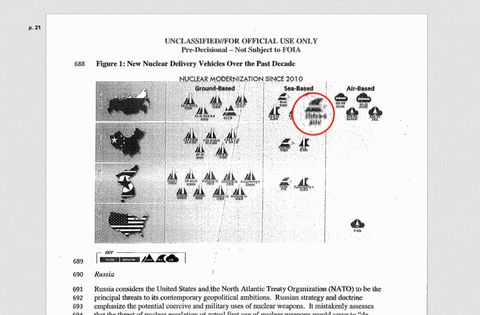A key U.S. nuclear weapons document confirms that the Russian government is developing the most powerful nuclear weapon in more than a half century. A leaked copy of the Pentagon’s Nuclear Posture Review states that Russia is developing a “new intercontinental, nuclear-armed undersea autonomous torpedo.”
The existence of the weapon, known as Kanyon to the Pentagon and "Ocean Multipurpose System Status-6" to Russia, was first leaked by Russian television in November 2015. A test involving the Sarov-class submarine mothership was leaked in December 2016. The Nuclear Posture Review report, dated January 2018, lists the weapon as part of Russia’s underwater nuclear arsenal. Here’s a screen capture, with Kanyon circled in red:
Kanyon is reportedly a very long range autonomous underwater vehicle that has a range 6,200 miles, a maximum depth of 3,280 feet, and a speed of 100 knots according to claims in leaked Russian documents.
But what really makes Kanyon nightmare fuel is the drone torpedo's payload: a 100-megaton thermonuclear weapon. By way of comparison, the atomic bomb dropped on Hiroshima was 16 kilotons, or the equivalent of 16,000 tons of TNT. Kanyon’s nuke would be the equivalent of 100,000,000 tons of TNT. That’s twice as powerful as Tsar Bomba, the most powerful thermonuclear weapon ever tested. Dropped on New York City, a 100-megaton bomb would kill 8 million people outright and injure 6 million more.
Kanyon is designed to attack coastal areas, destroying cities, naval bases, and ports. The mega-bomb would also generate an artificial tsunami that would surge inland, spreading radioactive contamination with the advancing water. To make matters worse there are reports the warhead is “salted” with the radioactive isotope Cobalt-60. Contaminated areas would be off-limits to humanity for up to 100 years.
Kanyon is designed to get around American ballistic missile defenses, primarily the Ground-Based Interceptor missiles based in Alaska and California. Although GBI is meant to counter small numbers of intercontinental ballistic missiles from rogue countries such as Iran and North Korea, Russia wants to make it abundantly clear that it could still penetrate U.S. defenses even if they were scaled up to deal with larger, more powerful nuclear arsenals.
Kanyon’s range and payload makes it much larger than existing torpedoes. According to submarine expert H.I. Sutton, Kanyon is 5.5 feet wide and 79 feet long, making it twice as large as a Bulava submarine launched ballistic missile. Sutton also believes the torpedo is nuclear powered.
The Russian Navy is testing Kanyon from a Sarov-class Russian Navy submarine. The unique, one-of-a-kind Sarov does not have any torpedo tubes of her own, but instead carries the nuclear-armed AUV externally attached to the pressure hull.




Post a Comment